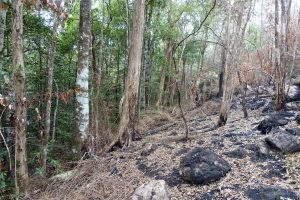After the fires – Nightcap National Park

Photo courtesy of Dr Robert Kooyman
While the Daintree wasn’t affected by the fires, many other significant Australian forests were. The wildfires that swept through Australia in 2019 and 2020 burnt over 10 million hectares of the landscape. Over 1 billion animals have lost their lives, including many threatened species that have been significantly impacted, creating an immediate need for well-informed action.
Several months later, COVID-19 closed state borders, and many are wondering what the landscape looks like now and what’s ahead. The Guardian takes you on a virtual journey through the blackened path of Australia’s summer of bushfires, including meeting up with Rainforest Rescue’s Scientific Advisor, Dr Robert Kooyman, to talk about the effects the fires had on Nightcap National Park in the Gondwanan forests – an area that Dr Robert has a deep connection to and has been working in for many years.
About a quarter of Kooyman’s beloved Nightcap national park, in the world-heritage listed Gondwana rainforests of northern New South Wales, was razed in November 2019.
© Natalie Grono (The Guardian)
“It’s a deeply emotional and visceral thing,” says Kooyman. “You can’t spend four decades in a place and know individual trees and then not be moved. There have been a lot of moments like that.”
A week or so after the fires had burned out in February, with trunks still smouldering, Kooyman headed straight for that misty spot in the park where he stands today.
Pink ribbons and stakes mark out observation plots where Kooyman is recording the forest’s every move – from changes in the leaf litter to every new shoot or dying tree.
He’s seeing some trees sprouting and seedlings emerging. But he is also seeing more trees dying.
© Natalie Grono (The Guardian)
“Tree death can be slow,” he says. “Once the base is burned and it’s gone through the bark, in the weeks and months after you’ll see a decline in the health of the canopy. I’m still seeing mortalities six months after the fires.
“We’ve lost hundreds of years of forest growth.”
There are 40 reserves that make up the world heritage-listed Gondwana rainforest area. More than half burned in the latest fires.
Read the full article, ‘Australia after the bushfires’ here, an article by Graham Readfearn, published by The Guardian on Wednesday 29 July 2020.
Further reading:
Big Scrub Remnants and Nature Reserves
Rocky Creek Dam and the Big Scrub Flora Reserve
Big Scrub Past and Present Map
Want more good Rainforest news in your life?
Subscribe to our eNews | Follow us on Instagram | Like us on Facebook | Subscribe to our YouTube channel
Help Protect Rainforests Forever
Donate to Protect Rainforests Forever | Become a Rainforest Guardian for as little as $2 a month | Partnership Options



